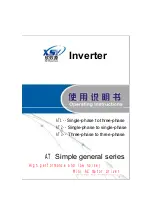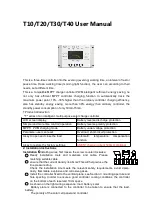
CobraNet, ACU16-C & NHB32-C Guide
29
Glossary
G
G
l
l
o
o
s
s
s
s
a
a
r
r
y
y
100Base-T:
See
Fast Ethernet.
100Base-FX:
Fast Ethernet utilizing multi-
mode fiber optic cables, with a maximum transmis-
sion distance of two kilometers. Single mode fiber
supports distances of over 100 kilometers.
100Base-TX:
Fast Ethernet utilizing Category 5
(CAT5) twisted pair data grade cables and RJ-45 con-
nectors. These cables are readily available in a range of
lengths and colors. The maximum allowed cable run
in an 100Base-T Ethernet network is 100 meters. If
you need to make custom cables, be sure to maintain
the natural twist of the conductors as close to the con-
nector as possible. More than 25 mm of untwisted
cable can affect performance. If you’re using cable
ties, don’t tighten them so as to deform the outer
insulation, and do not bend cables tightly. Doing so
may affect the cable’s impedance and degrade perfor-
mance.
1000Base-T:
See
Gigabit Ethernet.
APJ:
The file name extension for NetworkAmp
Manager projects (e.g., My project.apj).
Asynchronous:
Not synchronized. Often used
to describe communications between devices that are
not synchronized by a common clock, in which data
is sent intermittently rather than in a steady stream.
CobraNet’s Serial Bridge is asynchronous.
Contrast
with
Isochronous.
Auto-negotiation:
The automatic negotia-
tions that go on between two network devices in
order to determine half/full-duplex operation and
transfer rate (e.g., 10, 100, 1000 Mbps) before actual
data transmission commences. Auto-negotiation
only works on switched networks. With repeater net-
works, all data transfers are half-duplex and the trans-
fer rate is determined by the slowest device on the
network. All CobraNet interfaces support auto-nego-
tiation.
Bridge:
Typically a device that allows data transfer
between networks using disparate protocols. The
NHB32-C offers a bridge between AES/EBU and
CobraNet format digital audio.
Bundle:
CobraNet distributes digital audio data
in bundles. Each Ethernet packet can carry one bun-
dle. A single bundle can carry eight channels of
20-bit/48 kHz digital audio, or seven channels of
24-bit/48 kHz digital audio. Bundles are numbered
from 1 through 65,279. Bundles can be transmitted
one-to-one (unicast) or one-to-many (multicast).
Network efficiency can be optimized by using all eight
channels in each bundle instead of, for example,
using four channels in two bundles or two channels in
four bundles.
See also
Multicast bundle
and
Unicast
bundle.
Bundle 0:
Not really a bundle as such, more of a
null setting that can be made on CobraNet devices to
disable transmission and reception as necessary.
CAT3:
Category 3 twisted pair cable supports a
maximum data transfer rate of 10 Mbps and is used
for 10Base-T Ethernet networks.
CAT5:
Category 5 twisted pair cable supports a
maximum data transfer rate of 100 Mbps and is used
for 100base-TX Ethernet networks.
CobraCAD:
Freely available software from Peak
Audio for verification and performance testing of
CobraNet network designs. The latest version
includes the ACU16-C and NHB32-C.
CobraNet:
Developed by Peak Audio, CobraNet
technology allows real-time uncompressed digital
audio distribution over industry standard 100Base-T
Ethernet networks. Up to 128 channels, 64 in each
direction, can be carried simultaneously over a
switched 100Base-T network (64 channels on
repeater networks). CobraNet currently supports a
48 kHz sampling rate with 16, 20, or 24-bit resolu-
tion. CobraNet devices can happily coexist with net-
worked computers, printers, etc., on a switched
100Base-T Ethernet network, however, a dedicated
network infrastructure is strongly recommended.
CobraNet audio channel:
In CobraNet
terminology, an audio channel is one 48 kHz digital
audio signal with a 16, 20, or 24-bit resolution.
Содержание ACU16-C
Страница 1: ......
Страница 32: ...2003 Yamaha Corporation...




































